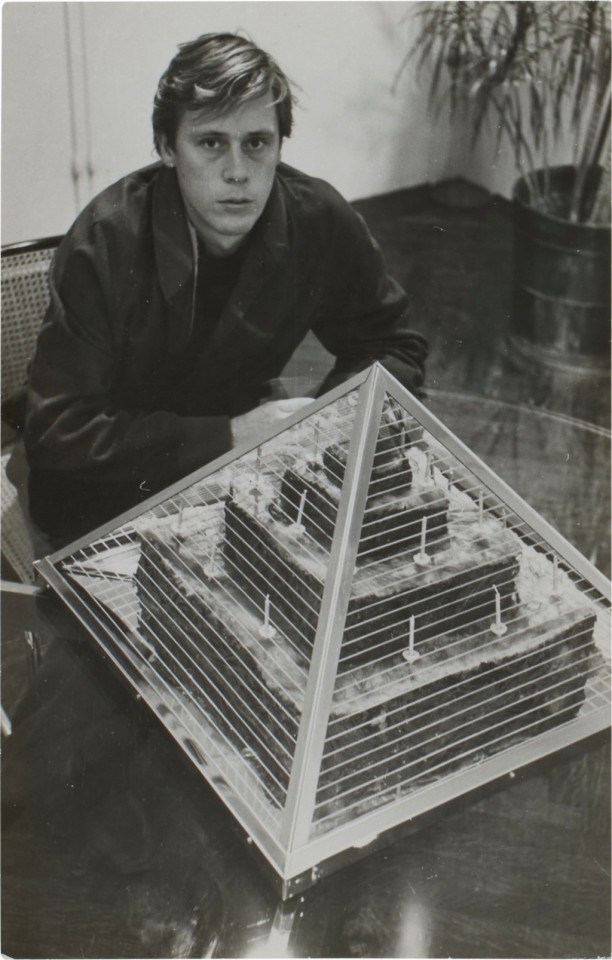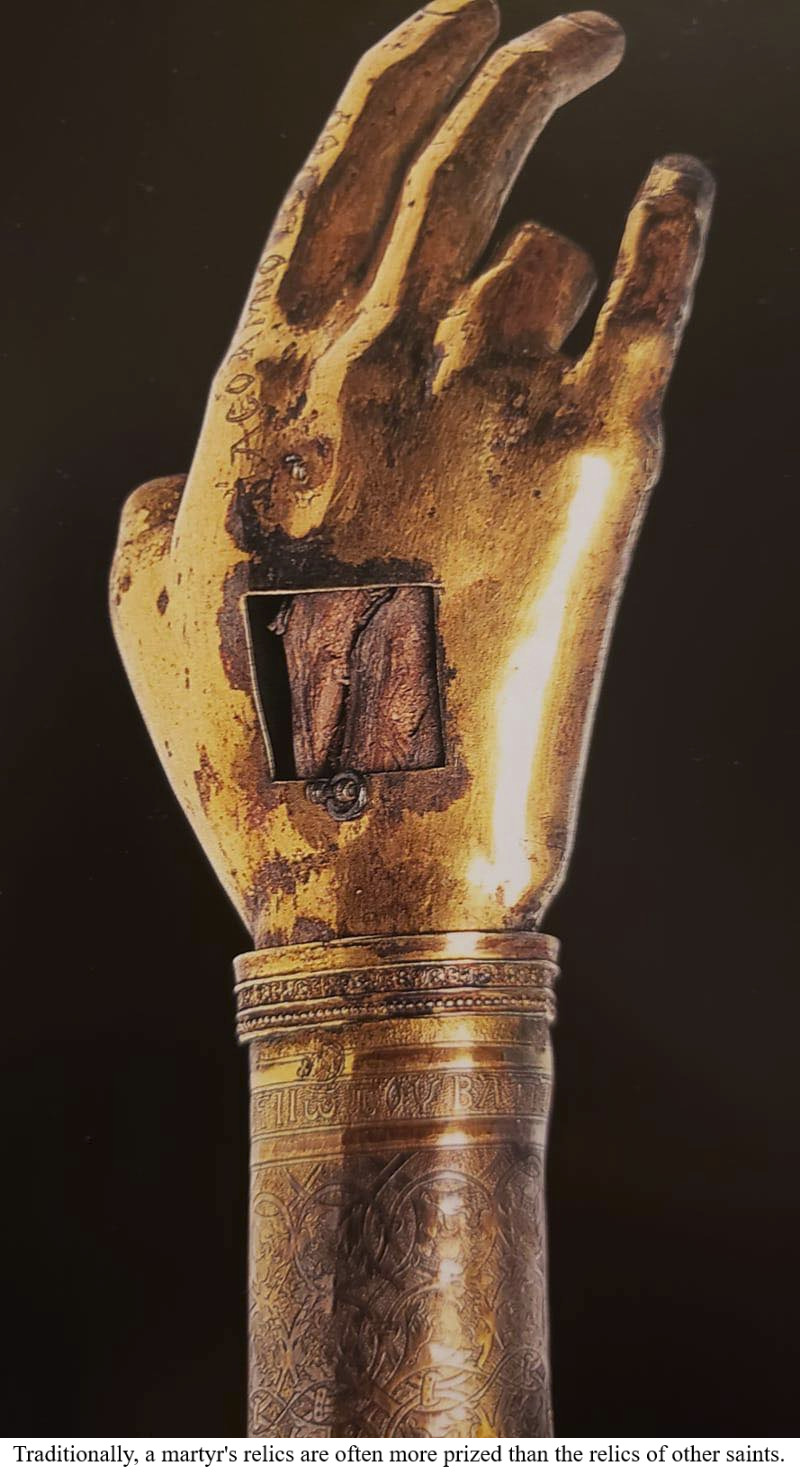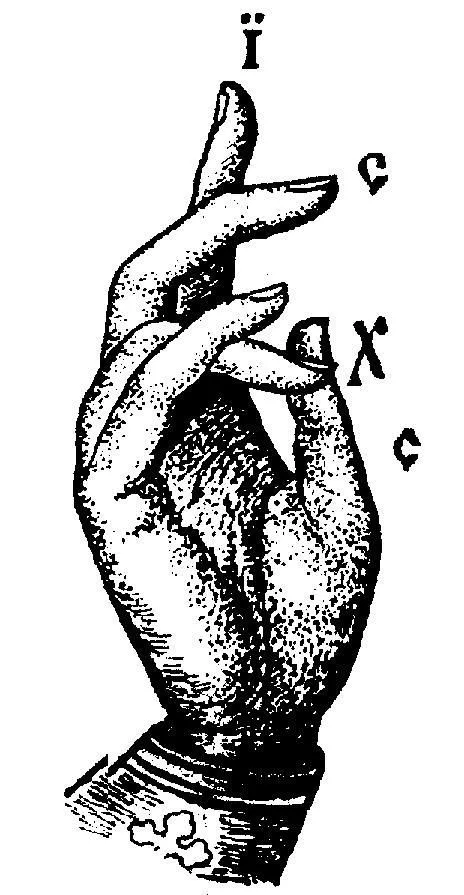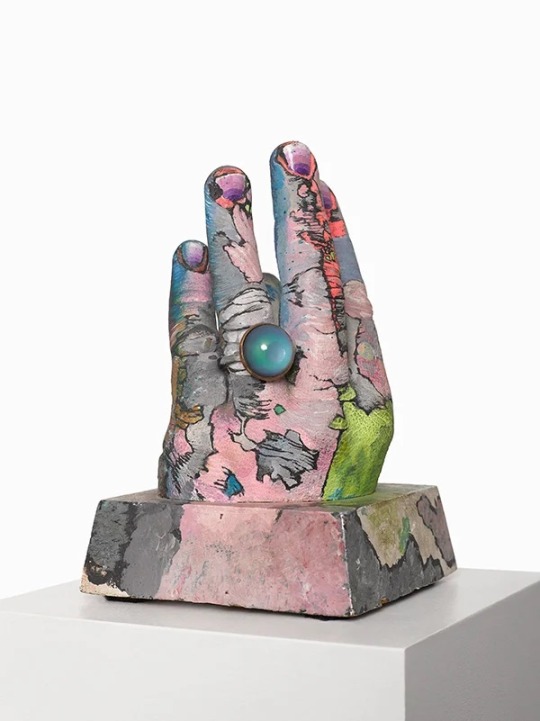#technological reliquaries
Text
Celebrating 11/11, november fools day in Cologne



37 notes
·
View notes
Text
Paul Thek's Birthday Cake of Flesh, c 1964

#paul thek#technological reliquaries#stable gallery#wax simulations of slabs of flesh also homages to minimalism why choose?#kenny schachter flipped this at sotheby's#1964#fred mcdarrah really saw it all and photographed most of it
8 notes
·
View notes
Text


'hippopotamus poison' + 'untitled' from the "technological reliquaries" series in paul thek: diver - a retrospective (2010)
823 notes
·
View notes
Text




























if we wanted to do discourse on motogp and catholicism at least we should do it the fun way
sources (pt 1): Reliquary, Wikipedia // Helmet, Instagram // Skull, Wikipedia // Glove, Twitter // Saint Teresa, El Confidencial // Relic, Wikipedia // Lorenzo Finger, Asphalt & Rubber // Hand of John, Facebook //Marquez Arm, Instagram // Arm of Jude, The Apostle of the Impossible // Christus on the Cross with Mary and St John, Wikipedia // Stigmata, Wikipedia // Quartararo Scar, Twitter // Stigmata, Zenit // Pedrosa Surgery, Honda Racing Corporation // Pedrosa Collarbone, Cycle News // Arm Pump, MotoGP // Marquez Surgery, MotoGP // Marquez Arm (2), Motorcycle Sports // Lorenzo in Water, FNCounter.com // Lorenzo in Water (2), TuttoMotoriWeb // Christ Walking On the Sea, Wikipedia //
pt 2: //Stained Glass, flickr // Ouroboros, Google // Valencia, Reddit // Crown of Thorns, Wikipedia // Christ Falling On the Way to Calvary, Wikipedia // Marquez Crash, MotoriOnline // Crown of Thorns, Twitter // Lorenzo Collarbone, Eurosport // Bezzechi Collarbone, motorsport.com // Marquez Sprint, MotorSportMagazin.com // Marquez Sprint (2), Honda Racing Corporation // Last Supper, Wikipedia // Ghent Altarpiece, The Guardian // The Crucifixion, The Metropolitan Musuem of Art //
pt 3: // Gestures, Aleteia // Rossi Conference, Road Racing World & Motorcycle Technology // Rossi Conference, Visordown // The Last Supper, Wikipedia // 2017 Aragon Press Conference, Twitter // 2018 Misano Press Conference, YouTube // The Taking of Christ, Wikipedia //Parc Ferme, motorsport.com // The Kiss of Judas, Wikipedia // Marquez on Rossi, Crash.net // Marquez on Rossi (2), Crash.net // Marquez Rossi Handshake, speedcafe.net // Marquez Rossi Handshake (2), Australian Motorcycle News // Creation of Adam, Wikipedia // Rossi Refuses Handshake, motorsport.com // 2014 Sepang, AutoRacing1.com // 2018 Argentina, YouTube // The Fallen Angel, Wikipedia // 2014 Qatar, MotoGP // 2015 Sepang, motorsport.com // Pieta, Daily Art Magazine // Stained Glass, Wikipedia // Ouroboros, tvtropes //
#tw injury#tw crash#motogp#eternalectics#i spent an unfathomable amount of time on this webweave. pls#web weave
174 notes
·
View notes
Text
Me shoveling slightly lesser known art history themes into my followers mouths: mmmmmm yummy it's so good right yummmmm yummy technological reliquaries mmmmmmm female ready-made artists yummy yummy yessss here comes the airplane it's the amputated body mhm yummmmmmm
50 notes
·
View notes
Text

Paul Thek, Untitled (Hand with Ring) from the series Technological Reliquaries, 1967, wood, plaster, paint and metal, 7-3/8" × 4-1/2" × 4-1/2" (18.7 cm × 11.4 cm × 11.4 cm) © The Estate of Paul Thek
39 notes
·
View notes
Photo

Paul Thek - Untitled (from the series 'Technological Reliquaries'), circa 1966-67
Wax, wood, metal, hair, plaster, paint, and Plexiglas with wig and fabric.
112 notes
·
View notes
Text

details from 'technological reliquaries' series in paul thek: diver - a retrospective (2010)
3 notes
·
View notes
Text

Celantri consists of four primary regions - Florene, Ishanyr, Auvedaya, and the Spiral Isles. Opposite the continents, there is nearly a full hemisphere of harsh, barren (?) seas.
Small islands may be classified as part of the nearest continent or as part of the sea they reside in. This is most significant in the case of the remains of the floating archipelago, now called Kalibaru, which are considered part of the Sea of Solace.

Constituting the waters between Ishanyr and Kalibaru, many have noted that the Sea of Solace is quite poorly named. This name once referred to its calm waters, but these days the sea is infamous as a hub for the magical underworld.
Kalibaru is the name given to the remains of the floating empire Kalirangka. It is about half the size of its predecessor with some parts having sunk entirely into the sea and many of the small traveling islands absorbed into other nations. The islands are terraced as they have always been, but due to the sunken portions, they are no longer arranged around a central point. While the rich and diverse culture and arts of the archipelago remain much the same, it's shunned its old practice of free sorcery, instead relegating it only to highly regulated government ventures, like their efforts to lift submerged layers of the islands back to the surface. Or at least that's what they say It's not really a secret that Kalibaru is rife with sorcerers who can do what they want as long as they don't rock the boat too hard. Convictions on account of sorcery are more often leveled against social pariahs than actual sorcerers. Although they reject the idolatry of their old religion, relationships with their ancestors are still of great importance. It is noted that Kalibaru has the lowest rate of natural born mages on Celantri. Reliquaries are now considered "radicals", but horns remain a prized, attractive feature than many emulate through headdresses or hairstyles. Even though the concept itself is controversial, those who do survive the transformation into Reliquaries are often prized by their communities. With more focus placed on local organizations, the central government of Kalibaru remains quite secretive. The remains of the hanging forests on the undersides of the islands and the spirits within them make the surrounding waters very dangerous.
Lantern Island is the nearest independent nation to old Kalirangka. During the Empyrean Wars, many deserters from Ishanyr fled here. After Kalirangka Utara disappeared, a great glistening fog drifted west and settled permanently over Lantern Island. Despite the ominous environment, the island's culture is generally vibrant and cheerful, albeit more superstitious than most. Local art and architecture tends towards rounded shapes, abstract patterns, and bright, bold colors. Much of the traditional "look" of Lantern Island was once considered a bold step towards streamlined, futuristic design that used the magical technology of Kalirangka to essentially achieve its aesthetic opposite. Today, it remains as a reminder of a lost future. Ancient structures and technology made using sorcery were not destroyed due to the belief that doing so would cause distortions, and today, they serve as public curiosities or even shrines that keep roaming spirits at bay. Magic is treated with equal parts reverence and caution. Visitors and new residents often report hearing an incessant, melodic hum on the island, though it usually disappears (or rather, they are no longer able to detect it) after a few weeks.
Yameruyi was one of the tiny traveling islands of Kalirangka Utara, used as a penal colony in the Perihelion Era until it was purchased by a former inmate whose identity has been long lost to time. The island is centered around a once volatile astral volcano, now calmed by the power of a specially-crafted relic. Rich in magical resources, it was "loaned out" during the Empyrean Wars had and contributed greatly to the... advancements made at the time. Today, Yameruyi has been co-opted by a powerful sorcerer's guild and serves as their mobile base. It is the only one of the traveling islands that still moves, though it can no longer fly, instead floating across the surface of the sea.
The Council for Magic Regulation maintains several bases across the Sea of Solace, but most notable is their floating base that trails after Yameruyi. It requires a large fleet of water Elementals to propel the gigantic structures. Although it is considered one of the Council's most important bases and a "prestigious" deployment location, it is widely known as a miserable place due to its isolation and the conflicts that occur around it. In order to keep international tensions to a low, the Council and the guilds avoid outright warfare and rely on espionage instead. Still, the prevalence of magic users on both sides means duels are likely to occur when they encounter one another.
Ishanyr was the last region to be reached by humans, but in the modern day it contains nearly half the world's population. Colonized by both species on opposite shores around the same time, it is the only one of the continents with anything near an equal demographic distribution. Throughout the late Perihelion Era, the brutal Empyrean Wars unfolded here.
Kistral is the home of the Council for Magic Regulation. It has carefully curated the highest rate of natural born mages (primarily Elementals) in the world. Anyone with natural born magic powers, including those who arrive from other countries, are afforded with housing, education, and ample opportunities. They are encourages to contribute to the Council's efforts if able. The infrastructure is both modern and highly integrated with the natural environment. However, its painfully obvious that the country is maintaining a caste system based on magic capacity. Those without any magic abilities are almost always forced into low-paying grunt work in order to survive, while the most powerful, especially soldiers, may do whatever they please. Sorcery is highly regulated and treated with suspicion, though it is a "necessary evil" to keep up with the developments of Ranlindyr and the guilds. Only those with authorization may attempt to become Reliquaries, and these individuals are often already born mages, anyways. Being a Reliquary without the Council's approval here is grounds for execution. Kistral has an infamously awful relationship with Ranlindyr.
Ranlindyr's otherwise flat landscape is covered in hollow, geometric monoliths made from a shiny black stone rise from the ground. These structures have been noted and recorded since the land was first settled. Rather than constructing traditional cities, these monoliths are fashioned into all types of facilities. Traditionally, portions of the monoliths will be decorated with ceramic tiles or be carved out and replaced with colorful glass. In the time since this practice began, researchers have discovered how to cause these monoliths to grow to their specifications, though the details remain a closely guarded secret. Traffic flows through raised tunnels connecting nearby structures and monorails that run along the Astral Realm's current. Once you enter a monolith, you're unlikely to make it back to ground level anytime soon. This architecture ensures that the wispy white fields of "ghost flowers" below are preserved. In the Aphelion Era, Ranlindyr is one of the few countries to expressly permit sorcery (with a license). It is home to the Horizon Communications Corporation, which discovered how to utilize the current as a means to send information and is easily the most powerful company on the planet today. It probably isn't too surprising that the company has come to has a strong pull in policy. Ranlindyr has been the worldwide center for technological innovation since the fall of Kalirangka; during the Empyrean Wars, it conducted many revolutionary yet controversial experiments.
Valonvyr and its northern neighbor Ranlindyr had once been so similar that no one bothered to draw a line between the two... until Valonvyr served as the frontlines of much of the Empyrean Wars. Heavy magical warfare and experimentation permanently terraformed the lush woodlands and grasslands into a mass of scorching deserts and toxic swamps. Large swaths of the land remain depopulated and difficult to navigate. While the same black monoliths that serve as the foundation of Ranlindyr were once just as common in Valonyr, they also ceased to grow. Now, the monoliths are left abandoned, occupied only by drifters and marauders. On the surface, Valonvyr appears to be little more than a ramshackle smattering of run down buildings, but its real wealth lies beneath the surface. During the Empyrean Wars, the most privileged built complex bunkers and tunnels beneath the surface that have been refined and developed into full-on underground cities, accessible only to those with the proper resources. Rumor has it that great ancient treasures lie in the deepest layers of Valonvyr. The only real surface cities are the capitals of each state that stand out like sparkling oasis in the desert. Business and government are one in the same here, and what you can get away with hinges entirely on who's involved. The country' states are always fighting with each other, but they'd band together long before they'd let anyone else interfere.
Xala-Basem is a state that split off from the Ishani Federation even before the great Ranlindyr-Valonvyr schism. Though tiny today, it was almost twice as large before the fall of Kalirangka caused sea levels to rise. It has the closest thing to a full magic ban possible - as a theocracy, magic is permitted only for use by the Temple. It is the governing body of the Zencari religion, which is popular throughout Ishanyr (though certainly not all sects actually listen to the governing body). With most technology on Celantri involving magic in some manner, the commoners of Xala-Basem live in essentially medieval conditions, though the temple does provide necessities for them. They do not banish spirits unless they pose a danger, so harmless sprites are everywhere. An incredibly strong magical boundary surrounds the country, making it difficult for outsiders to enter without approval. The tiny nation is often treated with derision by outsiders who are not part of the faith (and sometimes those who are) for its rejection of magic.
Auvedaya, the Eastern continent, is where the Awani first evolved along the coast. Its distinctive arc shape is a result of the Great Impact. Without a single landlocked country, the ocean keeps Auvedaya's climate quite tolerable. It is home to a variety of civilizations that are always competing for riches and influence, and wars were more often waged on an economic front rather than a martial one.
Florene in the West is actually two continents. The Gunari first evolved within the caves and mountains of North Florene. The landscape of both continents is harsh and unforgiving, contributing to the militant, survivalist tendencies of the species. The north is mountainous with extreme weather, and clans often had to fight for resources. South Florene is even more dangerous with forests so dense that no light reaches the ground, highly prone to distortions and crawling with mysterious creatures and malicious spirits. A large portion called the Phantasmagoria remains mostly unexplored to this day.
The Spiral Isles lie south of Auvedaya, populated primarily by Awani who migrated south long ago. As an archipelago, they have a strong tradition of seafaring. The Spiral Isles generally refuse to engage in the great conflicts unfolding in the rest of the world but are heavily involved in trade, as many of their resources are prized and exotic to foreigners.
10 notes
·
View notes
Text
Happy birthday to Professor Ellen Anders!
Today is her -479th birthday!

Anders was born on Arcadia and taught Theoretical Xenobiology at Rishard University. In 2531, she was kidnapped by ONI operatives on a referral by Dr. Halsey. Anders, who had a tense relationship with her former teacher, was initially furious, but agreed to act as a consultant to ONI after being shown photos from Harvest at the start of the Human-Covenant War.
She was intrigued that the Covenant referred to Harvest as a "treasure world" (which the Covenant would have called a reliquary). She was assigned to the UNSC Spirit of Fire to investigate these claims. Once on the ground, she interfaced with a Forerunner device which displayed coordinates. Using those, she lead the crew to her home of Arcadia. There, she was kidnapped by Arbiter Ripa 'Moramee, who was instructed to bring her to the Covenant's next location after witnessing how Forerunner technology responded to her.
The Spirit of Fire followed her neural implant signal to the Forerunner shieldworld know as Trove (Etran Harborage to the Foreunners). She was forced to activate a terminal, which began to power the fleet of Forerunner dreadnoughts stored in the planet. While her captors were distracted, she escaped using a teleportation pad and reunited with the Spirit of Fire crew.
Having witnessed the might of the Forerunner fleet for herself, Anders realized that the Covenant had to be prevented from utilizing the fleet at all costs. She devised a plan to destroy Trove, at the cost of Spirit's slipspace drive, and, ultimately, Sergeant Forge's life. After Spirit of Fire fled, they were stuck drifting, and Anders joined the crew in cryosleep until the ship detected a friendly signal.
Twenty-eight years later, the crew was awakened after coming into proximity to the Ark. They were detected by the Banished, who attacked them shortly thereafter. Anders was able to get access to the Ark's cartographer, and learned the significance of the installation. She also discovered that the Ark served as a foundry, and devised a plan to send a new Halo ring--Installation 09, to the location of first-discovered Halo, Installation 04, to act as a distress beacon. Thus, the Spirit of Fire's priorities changed to taking the Ark for the UNSC. Anders was on Installation 09 when it began to enter slipspace. Unable to get off in time, she was taken into slipspace, but the jump ended prematurely. In this mystery location, she encountered a Guardian. Her current status is unknown.
In canon (~2560), she is turning 57!
16 notes
·
View notes
Photo

Né à Brooklyn en 1933, Paul Thek fait ses études à l’Art Students League, au Pratt Institute et à la Cooper Union. Au cours d’un séjour en Sicile, puis à Rome en 1963, avec le photographe Peter Hujar, il est profondément frappé par les catacombes et les reliquaires. Il commence peu après la série des “Technological Reliquaries” (1964-1967), basée sur la rencontre entre des cires anatomiques et des matériaux industriels. Le travail de Paul Thek, qui fréquente les milieux underground réunis autour de la Factory de Andy Warhol, ainsi que le cercle de Susan Sontag, offre une réponse critique au minimalisme et au Pop Art. À la fin des années 60, Thek s’installe en Europe, où il réalise des installations où les visiteurs peuvent pénétrer dans l’espace ainsi créé, où il mêle art, littérature, théâtre et religion. Il meurt du sida en 1988.
25 notes
·
View notes
Text


( I do not own Hellboy or any of Mike Mignola's works besides my own original works)
So for anyone not familiar with Irish lore, Pooka, or Phooka, are mischievous shapeshifting fae. They can give advice to humans in their tongue and even sometimes offer prophetic lines. They're well known to take the form of a black horse with golden eyes, luring weary travelers to riding their back. However, unlike Kelpies, they don't do actual harm to their riders, granted they won't let them off unless they desire. They're known to run to incredible speeds through the countryside and running through fences for a wild ride that lasts until dawn. They can take the form of humans if they desire but will retain some of their animalistic traits. While mainly known to play mostly harmless tricks, think the Chesire Cat or Puck, they can use their magic to make someone's life a misery with misfortune to boot. Above, is my art of Diyana in her true form based on other interpretations of pookas.
Diyana here is about the size of a chimp, making it easy to slip into small spaces and go undetected in large well shaded areas.
Diyana or Di, is one of the Enhanced talent agents working for the B.P.R.D. She joined the Bureau in 1953 a year after Hellboy officially started working on missions. She did meet Hellboy before joining, specifically during a job to ensure some Mesopotamian artifacts were safely transported for research. She was there because she stole a reliquary right under the researchers' noses and a jewel from one of the mummies just for fun. It was the latter that was immediately noticed by the on-site staff including Hellboy. This led to a brief chase with the giant red man in hot pursuit of an elusive faerie. Diyana ran circles around Hellboy and the other agents after her, outwitting and outfoxing them at every turn until they managed to corner her. Rather than upset, Diyana congratulated the agents for their efforts and thank them for such an entertaining chase, ultimately giving back the jewel she stole and then teleporting out.
Thinking she was gone, imagine Hellboy's surprise when Diyana approached Professor Broom with an interesting proposition. Diyana offered to work with the BPRD as one of their agents and lent them her resources and funding from her company, Plume Deluxe, to sponsor the BPRD. In return, she gets the opportunity to work with Hellboy himself and access to the BPRD's own resources to further her research. Broom accepted, seeing as Di's inventions are a mix of magic and technology would be a major game-changer for the BPRD; much to his adopted son's chagrin. Yet, Diyana was content with the arrangement as she found the demon hybrid to be entertaining.
Needless to say, Hellboy and Diyana didn't quite get along at first.
#Hellboy#HellboyOC#original character#Diyana Swann#Pooka#púca#phooka#Faerie#Mike Mignola#hellboy and the bprd#BPRD#mignolaverse#comic fanart#hellboy fanart#My art#flirting#long post#fanfiction#Hand drawn art
6 notes
·
View notes
Text

Paul Thek, Untitled (Dental Plate #3), 1966.
*From the series Technological Reliquaries
2 notes
·
View notes
Text

'untitled (detail),' 1966 from the "technological reliquaries" series in paul thek: diver - a retrospective (2010)
411 notes
·
View notes
Text

The History and Significance of Gold Jewelry
Gold jewelry has captivated people for millennia, symbolizing wealth, power, and beauty. At DSire Jewelry, we honor the rich heritage and enduring allure of gold in our designs. Let's delve into the fascinating history and significance of gold jewelry.
Ancient Beginnings
Gold's history as a precious metal dates back to ancient civilizations:
Egypt: The ancient Egyptians were among the first to use gold for jewelry around 3000 BCE. They believed gold was the flesh of the gods and used it to create intricate jewelry for pharaohs and nobility.
Mesopotamia: Gold jewelry from Mesopotamia (modern-day Iraq) dates back to 2600 BCE. They crafted elaborate headdresses, earrings, and necklaces, often incorporating gemstones.
India: Gold has been integral to Indian culture for over 4,000 years. It symbolizes purity, prosperity, and status. Indian gold jewelry is known for its intricate designs and craftsmanship.
Classical Civilizations
Gold continued to hold great significance in classical civilizations:
Greece: Ancient Greeks used gold to create jewelry inspired by nature, mythology, and art. Gold wreaths, earrings, and necklaces were popular among the elite.
Rome: The Romans expanded gold mining and used gold for currency and jewelry. Roman gold jewelry often featured intricate designs and incorporated colored gemstones.
Medieval and Renaissance Eras
During the medieval period, gold jewelry became a symbol of religious devotion and status:
Medieval Europe: Gold was used to create religious artifacts, including crosses and reliquaries. Nobility wore gold jewelry adorned with gemstones to signify their rank.
Renaissance: The Renaissance era saw a resurgence in the use of gold for artistic expression. Jewelry became more elaborate, incorporating enamel and detailed engravings.
The Modern Era
Gold jewelry has evolved, but its allure remains timeless:
Victorian Era: Gold jewelry in the Victorian era (1837-1901) featured intricate designs and symbolism. Lockets, brooches, and mourning jewelry were popular.
20th Century: The 20th century saw the rise of new jewelry styles, from Art Deco to modern minimalist designs. Gold jewelry became more accessible to the public.
Contemporary: Today, gold jewelry continues to be a symbol of luxury and elegance. Advances in technology and design allow for innovative and personalized pieces.
Significance of Gold Jewelry
Gold jewelry holds deep cultural and emotional significance:
Wealth and Status: Throughout history, gold has been a symbol of wealth and status. It continues to represent financial security and success.
Cultural Traditions: In many cultures, gold jewelry is an essential part of weddings, festivals, and religious ceremonies. It symbolizes prosperity, good fortune, and blessings.
Personal Expression: Gold jewelry is a form of personal expression. Whether it's a statement piece or a delicate necklace, gold jewelry reflects individual style and taste.
Investment: Gold jewelry is not only beautiful but also a valuable investment. Its enduring value makes it a cherished heirloom passed down through generations.
At DSire Jewelry, we celebrate the rich history and timeless significance of gold jewelry in our collections. Explore our exquisite range of gold jewelry, crafted with passion and precision, to find pieces that resonate with your style and heritage. Visit our website or store to discover the allure of gold jewelry today.
0 notes
Text

THE DARK KNIGHT’S POCKET WATCH
STATUS: RECOVERED
[ Reliquary Masterpost ]
A German-made brass pocket watch dating from the early to the mid-sixteenth century. It bears no significant power, despite its owner’s supernatural status. One of the few relics that are more akin to trophies or mementos.
The provenance of this timepiece is absolutely fascinating– to be fair, its owner is an equally fascinating gentleman as well. Made by Peter Henlein himself in Nuremberg, it was one of his commissions from the time he began his large-scale spring-driven “pocket clocks”. I had to hazard a guess, likely it was made in the 1530s. The watch was clearly well maintained and cared for over the last 400 odd years, as it is still very much in working condition.
The owner has been known to history for being eccentric and almost always at the forefront of technology. No doubt this was a piece shown off among the Renaissance Elites in the day for sure.
How did I come to have it? Simply put: I pickpocketed it. At first, at least. He was visiting the Bureau when I was a child and saw a chance simply too good to pass up. I was going to give it back. Eventually I did give it back… when I was caught. The Dark Knight was more amused than anything. He encouraged it, much to father’s dismay, and I would subsequently make attempts for every visit we had. Up until right before he disappeared. I wonder if he had known what his fate was, as at one of our last meetings he simply made no attempt to take it back, and when I went to return it…he simply said it was mine to keep.
I have kept it with me ever since.
0 notes